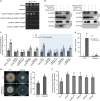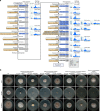A phosphorylated transcription factor regulates sterol biosynthesis in Fusarium graminearum
- PMID: 30874562
- PMCID: PMC6420630
- DOI: 10.1038/s41467-019-09145-6
A phosphorylated transcription factor regulates sterol biosynthesis in Fusarium graminearum
Abstract
Sterol biosynthesis is controlled by transcription factor SREBP in many eukaryotes. Here, we show that SREBP orthologs are not involved in the regulation of sterol biosynthesis in Fusarium graminearum, a fungal pathogen of cereal crops worldwide. Instead, sterol production is controlled in this organism by a different transcription factor, FgSR, that forms a homodimer and binds to a 16-bp cis-element of its target gene promoters containing two conserved CGAA repeat sequences. FgSR is phosphorylated by the MAP kinase FgHog1, and the phosphorylated FgSR interacts with the chromatin remodeling complex SWI/SNF at the target genes, leading to enhanced transcription. Interestingly, FgSR orthologs exist only in Sordariomycetes and Leotiomycetes fungi. Additionally, FgSR controls virulence mainly via modulating deoxynivalenol biosynthesis and responses to phytoalexin.
Conflict of interest statement
The authors declare no competing interests.
Figures










Similar articles
-
Involvement of FgERG4 in ergosterol biosynthesis, vegetative differentiation and virulence in Fusarium graminearum.Mol Plant Pathol. 2013 Jan;14(1):71-83. doi: 10.1111/j.1364-3703.2012.00829.x. Epub 2012 Sep 4. Mol Plant Pathol. 2013. PMID: 22947191 Free PMC article.
-
The transcription factor FgMed1 is involved in early conidiogenesis and DON biosynthesis in the plant pathogenic fungus Fusarium graminearum.Appl Microbiol Biotechnol. 2019 Jul;103(14):5851-5865. doi: 10.1007/s00253-019-09872-2. Epub 2019 May 21. Appl Microbiol Biotechnol. 2019. PMID: 31115634
-
The transcription factor FgCreA modulates ergosterol biosynthesis and sensitivity to DMI fungicides by regulating transcription of FgCyp51A and FgErg6A in Fusarium graminearum.Int J Biol Macromol. 2025 Jan;284(Pt 1):137903. doi: 10.1016/j.ijbiomac.2024.137903. Epub 2024 Nov 23. Int J Biol Macromol. 2025. PMID: 39581416
-
Trichothecene biosynthesis in Fusarium species: chemistry, genetics, and significance.Microbiol Rev. 1993 Sep;57(3):595-604. doi: 10.1128/mr.57.3.595-604.1993. Microbiol Rev. 1993. PMID: 8246841 Free PMC article. Review.
-
Fungal Cytochrome P450s and the P450 Complement (CYPome) of Fusarium graminearum.Toxins (Basel). 2018 Mar 7;10(3):112. doi: 10.3390/toxins10030112. Toxins (Basel). 2018. PMID: 29518888 Free PMC article. Review.
Cited by
-
Overproduction of mycotoxin biosynthetic enzymes triggers Fusarium toxisome-shaped structure formation via endoplasmic reticulum remodeling.PLoS Pathog. 2024 Jan 2;20(1):e1011913. doi: 10.1371/journal.ppat.1011913. eCollection 2024 Jan. PLoS Pathog. 2024. PMID: 38166144 Free PMC article.
-
The Transcription Factor FgAtrR Regulates Asexual and Sexual Development, Virulence, and DON Production and Contributes to Intrinsic Resistance to Azole Fungicides in Fusarium graminearum.Biology (Basel). 2022 Feb 18;11(2):326. doi: 10.3390/biology11020326. Biology (Basel). 2022. PMID: 35205191 Free PMC article.
-
Normal distribution of H3K9me3 occupancy co-mediated by histone methyltransferase BcDIM5 and histone deacetylase BcHda1 maintains stable ABA synthesis in Botrytis cinerea TB-31.Front Microbiol. 2024 Mar 4;15:1339576. doi: 10.3389/fmicb.2024.1339576. eCollection 2024. Front Microbiol. 2024. PMID: 38500582 Free PMC article.
-
The decrotonylase FoSir5 facilitates mitochondrial metabolic state switching in conidial germination of Fusarium oxysporum.Elife. 2021 Dec 20;10:e75583. doi: 10.7554/eLife.75583. Elife. 2021. PMID: 34927582 Free PMC article.
-
Transcription factor control of virulence in phytopathogenic fungi.Mol Plant Pathol. 2021 Jul;22(7):858-881. doi: 10.1111/mpp.13056. Epub 2021 May 11. Mol Plant Pathol. 2021. PMID: 33973705 Free PMC article. Review.
References
Publication types
MeSH terms
Substances
Grants and funding
LinkOut - more resources
Full Text Sources

